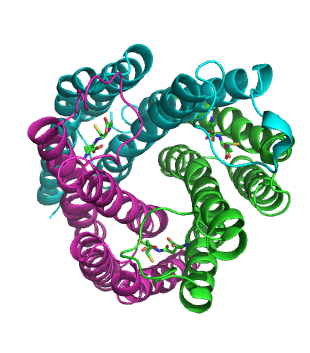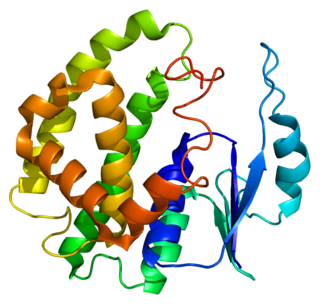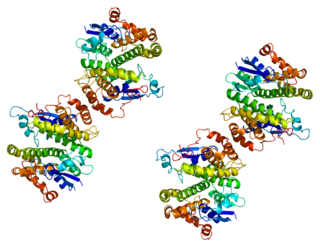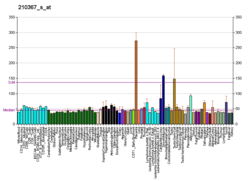
Prostaglandin E synthase is an enzyme involved in eicosanoid and glutathione metabolism, a member of MAPEG family. It generates prostaglandin E (PGE) from prostaglandin H2.

Leukotriene C4 synthase is an enzyme that in humans is encoded by the LTC4S gene.

Cyclooxygenase-2 (COX-2), also known as prostaglandin-endoperoxide synthase 2 (HUGO PTGS2), is an enzyme that in humans is encoded by the PTGS2 gene. In humans it is one of three cyclooxygenases. It is involved in the conversion of arachidonic acid to prostaglandin H2, an important precursor of prostacyclin, which is expressed in inflammation.

Glutathione S-transferase A1 is an enzyme that in humans is encoded by the GSTA1 gene.

Prostaglandin E synthase 3 (cytosolic) is an enzyme that in humans is encoded by the PTGES3 gene.

Glutathione S-transferase Mu 2 is an enzyme that in humans is encoded by the GSTM2 gene.

Hyaluronan synthase 2 is an enzyme that in humans is encoded by the HAS2 gene.

Glutathione peroxidase 2 is an enzyme that in humans is encoded by the GPX2 gene.

Glutathione S-transferase A4, also known as GSTA4, is an enzyme which in humans is encoded by the GSTA4 gene.

Alpha-N-acetylneuraminide alpha-2,8-sialyltransferase is an enzyme that in humans is encoded by the ST8SIA1 gene.

Glutathione S-transferase Mu 4 is an enzyme that in humans is encoded by the GSTM4 gene.

Hyaluronan synthase 1 is an enzyme that in humans is encoded by the HAS1 gene.

Microsomal glutathione S-transferase 1 is an enzyme that in humans is encoded by the MGST1 gene.

Ceramide glucosyltransferase is an enzyme that in humans is encoded by the UGCG gene.

PGDS protein is a protein that in humans is encoded by the HPGDS gene.

In molecular biology the MAPEG family of proteins are a group of membrane associated proteins with highly divergent functions. Included are the 5-lipoxygenase-activating protein, leukotriene C4 synthase, which catalyzes the production of leukotriene C4 (LTC4) from leukotriene A4 (LTA4), and microsomal glutathione S-transferase II (GST-II), which also produces LTC4 from LTA4.

Microsomal glutathione S-transferase 2 is an enzyme that in humans is encoded by the MGST2 gene.

Microsomal glutathione S-transferase 3 is an enzyme that in humans is encoded by the MGST3 gene.

Microsomal prostaglandin E synthase-2 (mPGES-2) or Prostaglandin E synthase 2 is an enzyme that in humans encoded by the PTGES2 gene located on chromosome 9. The protein encoded by this gene is a membrane-associated prostaglandin E synthase, which catalyzes the conversion of prostaglandin H2 to prostaglandin E2. This protein also has been shown to activate the transcription regulated by a gamma-interferon-activated transcription element (GATE). Multiple transcript variants have been found for this gene.

Glutathione peroxidase 5 (GPx-5), also known as epididymal secretory glutathione peroxidase is an enzyme that in humans is encoded by the GPX5 gene.























